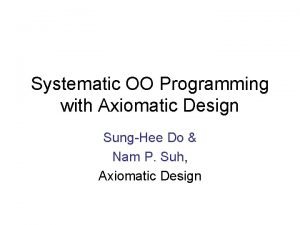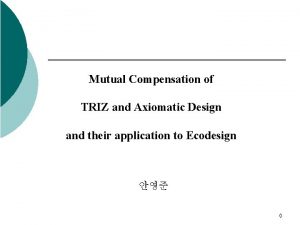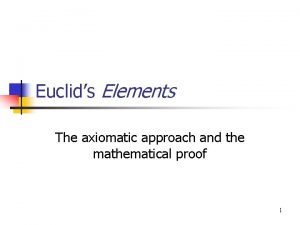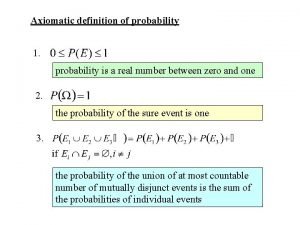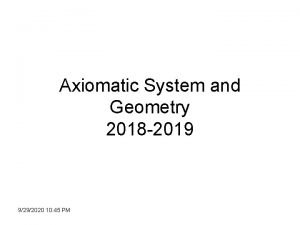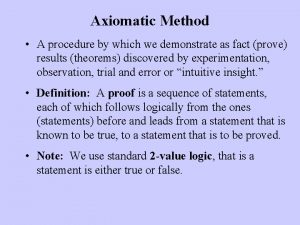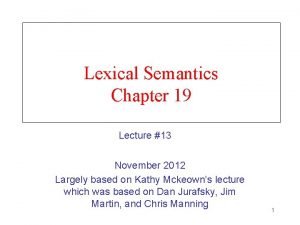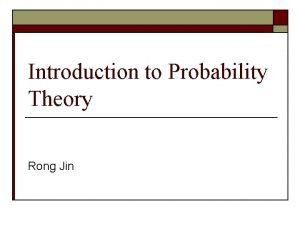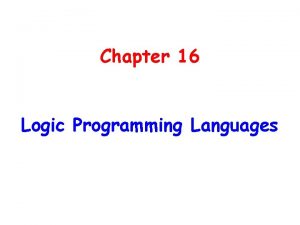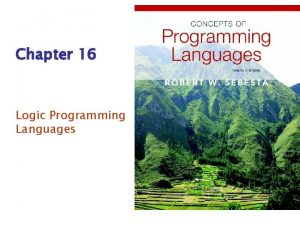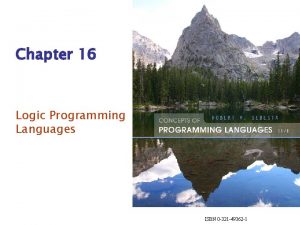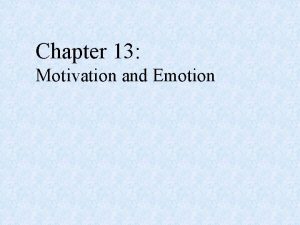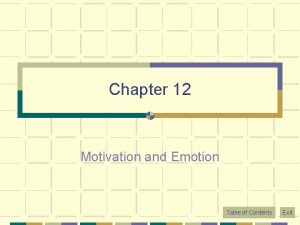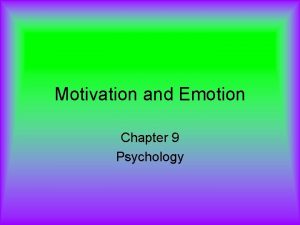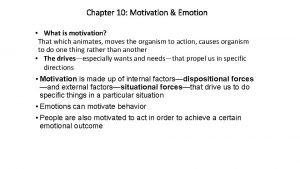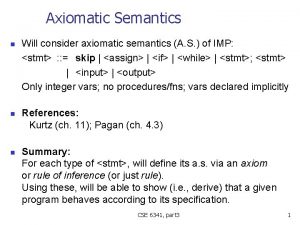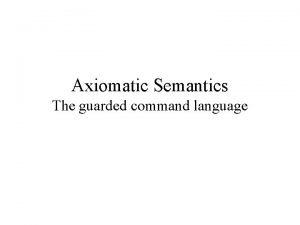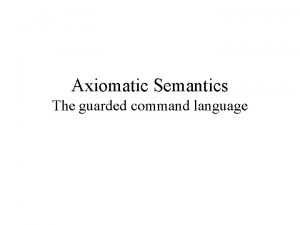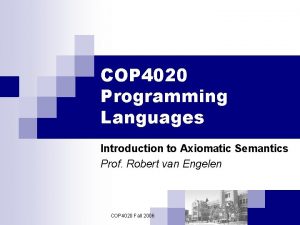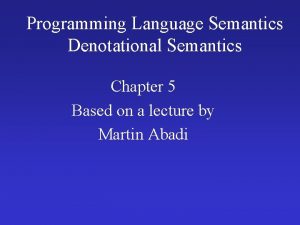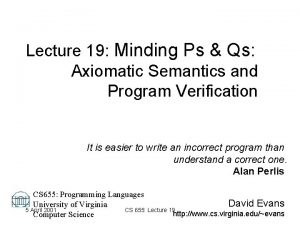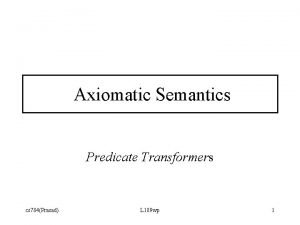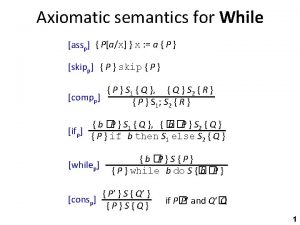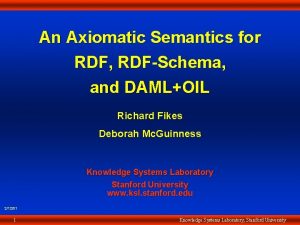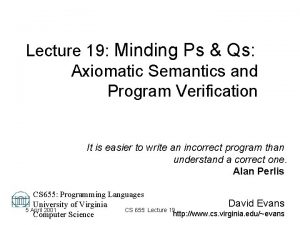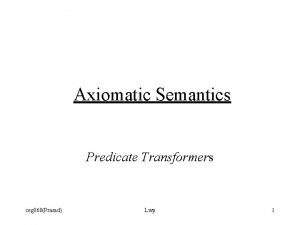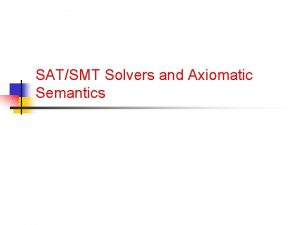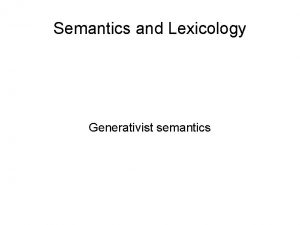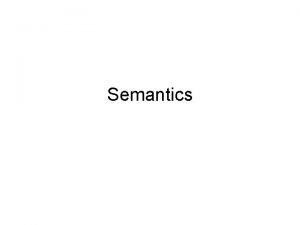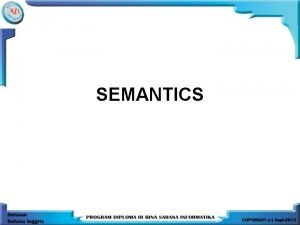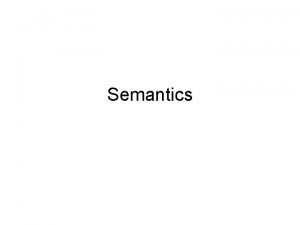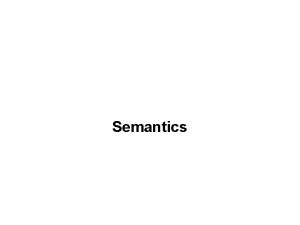Programming Language Semantics Axiomatic Semantics Chapter 6 Motivation








![Total Correctness • [P]c[Q] – P and Q are assertions (extensions of Boolean expressions) Total Correctness • [P]c[Q] – P and Q are assertions (extensions of Boolean expressions)](https://slidetodoc.com/presentation_image/b6b0710a2c87940fb7a359e7b8507283/image-9.jpg)










![Semantics of Assertions (II) • I[n/i] change i in I to n • For Semantics of Assertions (II) • I[n/i] change i in I to n • For](https://slidetodoc.com/presentation_image/b6b0710a2c87940fb7a359e7b8507283/image-20.jpg)





![Hoare Proof Rules for Partial Correctness {A} skip {A} {B[a/X]} X: =a {B} {P} Hoare Proof Rules for Partial Correctness {A} skip {A} {B[a/X]} X: =a {B} {P}](https://slidetodoc.com/presentation_image/b6b0710a2c87940fb7a359e7b8507283/image-26.jpg)




- Slides: 30

Programming Language Semantics Axiomatic Semantics Chapter 6

Motivation • What do we need in order to prove that the program does what it supposed to do? • Specify the required behavior • Compare the behavior with the one obtained by the denotational/operational semantics • Develop a proof system for showing that the program satisfies a requirement • Mechanically use the proof system to show correctness • The meaning of a program is a set of verification rules

Plan • • The basic idea An assertion language Semantics of assertions Proof rules An example Soundness Completeness

Example Program S: =0 N : = 1 while (N=101) do S : = S + N ; N : =N+1 N=101 S=∑ 1 m 100 m

Example Program S: =0 {S=0} N : = 1 {S=0 N=1} while (N=101) do S : = S + N ; N : =N+1 {N=101 S=∑ 1 m 100 m}

Example Program S: =0 {S=0} N : = 1 {S=0 N=1} while (N=101) do S : = S + N ; N : =N+1 {N=101 S=∑ 1 m 100 m}

Example Program S: =0 {S=0} N : = 1 {S=0 N=1} while {1 N 101 S=∑ 1 m N-1 m} (N=101) do S : = S + N ; {1 N < 101 S=∑ 1 m N m} N : =N+1 {N=101 S=∑ 1 m 100 m}

Partial Correctness • {P}c{Q} – P and Q are assertions (extensions of Boolean expressions) – c is a command – For all states which satisfies P, if the execution of c from state terminates in state ’, then ’ satisfies Q • {true}while true do skip{false}
![Total Correctness PcQ P and Q are assertions extensions of Boolean expressions Total Correctness • [P]c[Q] – P and Q are assertions (extensions of Boolean expressions)](https://slidetodoc.com/presentation_image/b6b0710a2c87940fb7a359e7b8507283/image-9.jpg)
Total Correctness • [P]c[Q] – P and Q are assertions (extensions of Boolean expressions) – c is a command – For all states which satisfies P, • the execution of c from state must terminates in a state ’ • ’ satisfies Q

Formalizing Partial Correctness • A – A is true in • {P} c {Q} – , ’ ∑. ( P & <c, > ’ ) ’ Q – ∑. ( P & C c ) C c Q • Convention for all A A • , ’ ∑. P C c Q

The Assertion Language • Extend Bexp • Allow quantifications – i: … • i. k=i l • Import well known mathematical concepts – n! n (n-1) 2 1

The Assertion Language Aexpv a: = n | X | i | a 0 + a 1 | a 0 - a 1 | a 0 a 1 Assn A: = true | false | a 0 = a 1 | a 0 a 1 | A 0 A 1 | i. A

Example while (M=N) do if M N then N : = N – M else M : = M - N

Free and Bound Variables • An integer variable is bound when it occurs in the scope of a quantifier • Otherwise it is free • Examples i. k=i L (i+100 77) i. j+1=i+3) FV(n) = FV(X) = FV(i) = {i} FV(a 0 + a 1)=FV(a 0 -a 1)=FV(a 0 a 1 ) = FV(a 0) FV(a 1) FV(true)=FV(false)= FV(a 0 = a 1)=FV(a 0 a 1)= FV(a 0) FV(a 1) FV(A 0 A 1)=FV(A 0 A 1)= FV(A 0) FV(A 1) FV( A)=FV(A) FV( i. A)= FV(A) {i}

Substitution • Visualization of an assertion A ---i--- • Consider a “pure” arithmetic expression A[a/i] ---a--n[a/i] = n X[a/i]=X i[a/i] = a j[a/i] = j (a 0 + a 1)[a/i] = a 0[a/i] + a 1/[a/i] (a 0 - a 1)[a/i] = a 0[a/i] – a 1[a/i] (a 0 a 1 )[a/i]= a 0[a/i] a 1[a/i]

Substitution • Visualization of an assertion A ---i--- • Consider a “pure” arithmetic expression A[a/i] ---a--true[a/i] = true false[a/i]=false (a 0 = a 1)[a/i] = (a 0/[a/i] = a 1[a/i]) (a 0 a 1)[a/i] = (a 0/[a/i] a 1[a/i]) (A 0 A 1)[a/i] = (A 0[a/i] A 1[a/i]) (A 0 A 1)[a/i]= (A 0[a/i] A 1[a/i]) (A 0 A 1)[a/i] = (A 0[a/i] A 1[a/i])[a/i] ( A)[a/i] = (A[a/i]) ( i. A)[a/i] = i. A ( j. A)[a/i] = ( i. A[a/i]) ( i. A)[a/i] = i. A ( j. A)[a/i] =( i. A[a/j])

Location Substitution • Visualization of an assertion A ---X--- • Consider a “pure” arithmetic expression A[a/X] ---a---

Example Assertions • i is a prime number • i is the least common multiple of j and k

Semantics of Assertions • An interpretation I: intvar N • The meaning of Aexpv – – – Av n I =n Av X I = (X) Av i I = I(i) Av a 0+a 1 I = Av a 0 I +Av a 1 I … • For all a Aexp states and Interpretations I – A a =Av a I
![Semantics of Assertions II Ini change i in I to n For Semantics of Assertions (II) • I[n/i] change i in I to n • For](https://slidetodoc.com/presentation_image/b6b0710a2c87940fb7a359e7b8507283/image-20.jpg)
Semantics of Assertions (II) • I[n/i] change i in I to n • For I and , define I A by structural induction – – – – I true I (a 0 = a 1) if Av a 0 I = Av a 1 I I (A B) if I A and I B I A if not I A B if (not I A) or I B) I i. A I[n/i] A for all n N A

Proposition 6. 4 For all b Bexp states and Interpretations I B b = true iff I b B b = false iff not I b

Partial Correctness Assertions • {P}c{Q} – P, Q Assn and c Com • For a state and interpretation I – I {P}c{Q} if ( I P C c I Q) • Validity – When , I {P}c{Q} we write • I {P}c{Q} – When , and I I {P}c{Q} we write • {P}c{Q} • {P}c{Q} is valid

The extension of an assertion AI { | I A }

The extension of assertions Suppose that (P Q) Then for any interpretation I . I P I Q PI QI QI PI

The extension of assertions Suppose that {P}c{Q} Then for any interpretation I . I P C c I Q C c PI QI PI C c QI
![Hoare Proof Rules for Partial Correctness A skip A BaX X a B P Hoare Proof Rules for Partial Correctness {A} skip {A} {B[a/X]} X: =a {B} {P}](https://slidetodoc.com/presentation_image/b6b0710a2c87940fb7a359e7b8507283/image-26.jpg)
Hoare Proof Rules for Partial Correctness {A} skip {A} {B[a/X]} X: =a {B} {P} c 0 {C} c 1 {Q} {P} c 0; c 1{Q} {P b} c 0 {Q} {P b} c 1 {Q} {P} if b then c 0 else c 1{Q} {I b} c {I} while b do c{I b} P P’ {P’} c {Q’} Q’ Q {P} c {Q}

Example while X > 0 do Y : = X Y; X : = X – 1

Soundness • Every theorem obtained by the rule system is valid – {P} c {Q} • The system can be implemented (HOL, LCF) – Requires user assistance • Proof of soundness – Every rule preserves validity (Theorem 6. 1)

Completeness • Every valid theorem can be derived by the rule system is valid – {P} c {Q} • But what about Gödel’s incompleteness? • Relative completeness – Assume that every math theorem is valid • Chapter 7 – Uses Weakest Preconditions

Summary • Axiomatic semantics provides an abstract semantics • Can be used to explain programming • Can be automated • More effort is required to make it practical
 Axiomatic design example
Axiomatic design example Systematic oo
Systematic oo Axiomatic system definition
Axiomatic system definition Axiomatic design
Axiomatic design The axiomatic method
The axiomatic method Axiomatic definition of probability
Axiomatic definition of probability Axiomatic system of geometry
Axiomatic system of geometry Definition in an axiomatic system
Definition in an axiomatic system Axiomatic antonym
Axiomatic antonym Axiomatic definition of probability
Axiomatic definition of probability Compare procedural semantics and declarative semantics.
Compare procedural semantics and declarative semantics. Hardware description language vs programming language
Hardware description language vs programming language Logical programming language
Logical programming language Chapter 16 programming language
Chapter 16 programming language Chapter 16 programming language
Chapter 16 programming language Perbedaan linear programming dan integer programming
Perbedaan linear programming dan integer programming Greedy vs dynamic programming
Greedy vs dynamic programming Windows 10 system programming, part 1
Windows 10 system programming, part 1 Linear vs integer programming
Linear vs integer programming Perbedaan linear programming dan integer programming
Perbedaan linear programming dan integer programming Motivation ap psychology
Motivation ap psychology Chapter 13 motivation and emotion
Chapter 13 motivation and emotion Chapter 12 motivation and emotion
Chapter 12 motivation and emotion Chapter 7 motivation concepts
Chapter 7 motivation concepts Example of motivation
Example of motivation Chapter 10 motivation and emotion
Chapter 10 motivation and emotion Dapps goal
Dapps goal Display rules psychology
Display rules psychology Motivation chapter
Motivation chapter Chapter 10 motivation and emotion
Chapter 10 motivation and emotion Chapter 8 motivation and emotion
Chapter 8 motivation and emotion

